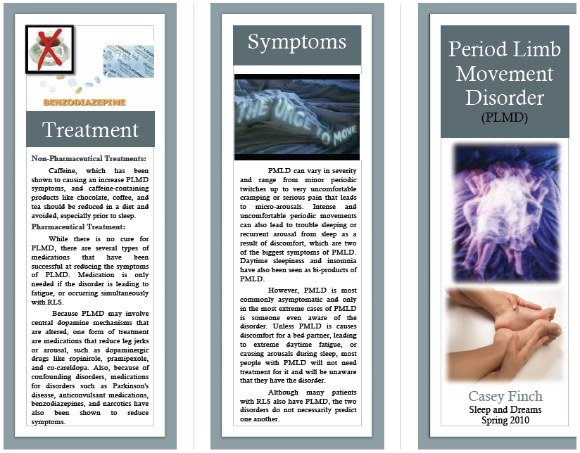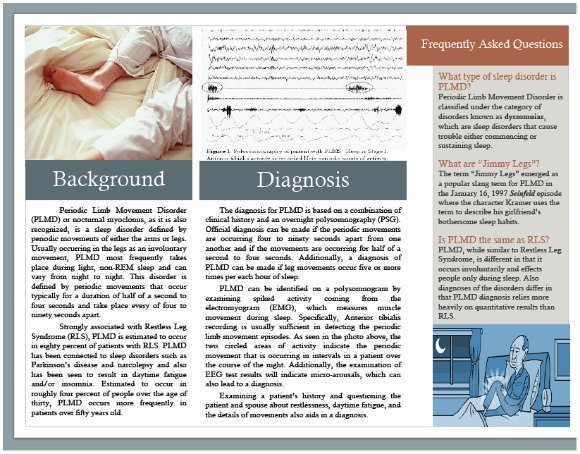
| Connect & Subscribe |
Periodic Limb Movement Disorder (PLMD) Brochure
An Outreach Project by Casey Finch | Return To Outreach Projects 2010
The following is a student-made brochure created for Stanford Sleep and Dreams. If it is difficult to read using the images, you may view the full text here.
Also feel free to download this brochure for distributional or general information purposes. Please refer to our privacy policy for our relevant disclaimers.


Background
Periodic Limb Movement Disorder (PLMD) or nocturnal myoclonus, as it is also recognized, is a sleep disorder defined by periodic movements of either the arms or legs. Usually occurring in the legs as an involuntary movement, PLMD most frequently takes place during light, non-REM sleep and can vary from night to night. This disorder is defined by periodic movements that occur typically for a duration of half of a second to four seconds and take place every of four to ninety seconds apart.
Strongly associated with Restless Leg Syndrome (RLS), PLMD is estimated to occur in eighty percent of patients with RLS. PLMD has been connected to sleep disorders such as Parkinson's disease and narcolepsy and also has been seen to result in daytime fatigue and/or insomnia. Estimated to occur in roughly four percent of people over the age of thirty, PLMD occurs more frequently in patients over fifty years old.
Symptoms
PMLD can vary in severity and range from minor periodic twitches up to very uncomfortable cramping or serious pain that leads to micro-arousals. Intense and uncomfortable periodic movements can also lead to trouble sleeping or recurrent arousal from sleep as a result of discomfort, which are two of the biggest symptoms of PMLD. Daytime sleepiness and insomnia have also been seen as bi-products of PMLD.
However, PMLD is most commonly asymptomatic and only in the most extreme cases of PMLD is someone even aware of the disorder. Unless PMLD is causes discomfort for a bed partner, leading to extreme daytime fatigue, or causing arousals during sleep, most people with PMLD will not need treatment for it and will be unaware that they have the disorder.
Although many patients with RLS also have PLMD, the two disorders do not necessarily predict one another.
Diagnosis
The diagnosis for PLMD is based on a combination of clinical history and an overnight polysomnography (PSG). Official diagnosis can be made if the periodic movements are occurring four to ninety seconds apart from one another and if the movements are occurring for half of a second to four seconds. Additionally, a diagnosis of PLMD can be made if leg movements occur five or more times per each hour of sleep.
PLMD can be identified on a polysomnogram by examining spiked activity coming from the electromyogram (EMG), which measures muscle movement during sleep. Specifically, Anterior tibialis recording is usually sufficient in detecting the periodic limb movement episodes. As seen in the photo above, the two circled areas of activity indicate the periodic movement that is occurring in intervals in a patient over the course of the night. Additionally, the examination of EEG test results will indicate micro-arousals, which can also lead to a diagnosis.
Examining a patient's history and questioning the patient and spouse about restlessness, daytime fatigue, and the details of movements also aids in a diagnosis.
Treatment
Non-Pharmaceutical Treatments:
Caffeine, which has been shown to cause an increase in PLMD symptoms, and caffeine-containing products like chocolate, coffee, and tea should be reduced in a diet and avoided, especially prior to sleep.
Pharmaceutical Treatment:
While there is no cure for PLMD, there are several types of medications that have been successful at reducing the symptoms of PLMD. Medication is only needed if the disorder is leading to fatigue, or occurring simultaneously with RLS.
Because PLMD may involve central dopamine mechanisms that are altered, one form of treatment are medications that reduce leg jerks or arousal, such as dopaminergic drugs like ropinirole, pramipexole, and co-careldopa. Also, because of confounding disorders, medications for disorders such as Parkinson's disease, anticonvulsant medications, benzodiazepines, and narcotics have also been shown to reduce symptoms.
Frequently Asked Questions
What type of sleep disorder is PLMD?
Periodic Limb Movement Disorder is classified under the category of disorders known as dyssomnias, which are sleep disorders that cause trouble either commencing or sustaining sleep.
What are "Jimmy Legs"?The term "Jimmy Legs" emerged as a popular slang term for PLMD in the January 16, 1997 Seinfeld episode where the character Kramer uses the term to describe his girlfriend's bothersome sleep habits.
Is PLMD the same as RLS?PLMD, while similar to Restless Leg Syndrome, is different in that it occurs involuntarily and effects people only during sleep. Also diagnoses of the disorders differ in that PLMD diagnosis relies more heavily on quantitative results than RLS.
Return To All Outreach Projects 2010
Learn more about sleep than 99% of the world with our Sleep Essentials Mini-Guide
About This Site
Welcome! This site is continuously being created by students of Dr. William C. Dement's Sleep And Dreams course at Stanford University.
We made this site as a call to action for people all over the world to live healthier, happier, safer, and more productive lives by learning about their own sleep. We have faith that reading the information provided on this site will motivate you to be smart about your sleep deprivation and strategic about your alertness in order to live life to your fullest, most energetic potential.
In fact, we challenge you to do so! What do you say, are you up for the challenge?
Interviews With Sleep Specialists: Insights Into the Worlds of Sleep Medicine & Sleep Business
America's Most Dangerous Disorder: What Is Sleep Apnea Doing To Your Sleep?
Sleep Debt: How Much More Will You Achieve When You Reduce Yours?
The Stages Of Sleep: The Journey Through The Night
Delayed Sleep Phase: You Want To Sleep But You're Not Tired Yet
Paralyzed at Night: Is Sleep Paralysis Normal?
Sleep In Words: Smart, Strange, and Funny Quotes About Sleep
Sleep Disorders In Children: What's Keeping Your Child From A Full Night's Rest?
Attacks of Pavor Nocturnus (a.k.a. Sleep Terrors, Night Terrors, or Incubus Attacks)
The Stanford Sleep Book
Dr. Dement's pioneering textbook has been the core text for Sleep and Dreams since 1980, but it has just recently been made available to the wider public for the first time.
In it you'll find a more detailed account of the most important things you need to know about sleep, alertness, dreams, and sleep disorders. Studies, statistics, plus plenty of Dr. Dement's classic anecdotes painting the history of sleep medicine.
Preface | Intro | Contents | Get A Copy
More Sleep Resources
The Zeo
A revolution in personal sleep tracking, the Zeo is a wireless headband that transmits your brainwaves in realtime to a dock (pictured here) or your smartphone. The result? You can wake up and see exactly what stages of sleep you were in during the night! Unprecedented personalized sleep knowledge.
Sleep Paralysis: A Dreamer's Guide
Ever woken up paralyzed? A surprising number of us have, believe it or not. But few know the actual causes of this phenomenon, and fewer still how to exert control over it. Dream researcher and sleep paralysis expert Ryan Hurd shares breakthrough insights into how to do just that.
Important Disclaimer
Please Note:
The information found on this page and throughout this site is intended for general information purposes only. While it may prove useful and empowering, it is NOT intended as a substitute for the expertise and judgments of healthcare practitioners.
For more info, see our
Terms of Use.









